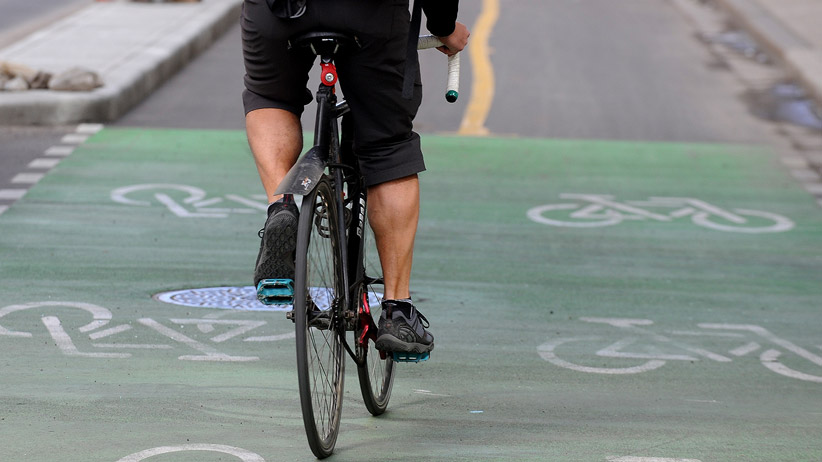The Editorial: Is there hope for a car-bike détente?
As the number of cyclists grows, so do the fatalities. Forget about talk of ‘war on the car’–let’s make roads work for all
A cyclist rides down the bike lanes on 7th street in downtown Calgary, Alta. on Monday April 28, 2014. Calgary City Hall is looking at putting more bike lanes in the downtown area. Stuart Dryden/Calgary Sun/QMI Agency
Share

After a forgettable 2013, the Winnipeg Blue Bombers were hoping for a better start to their upcoming Canadian Football League season. Unfortunately, last week, their first pre-season game (another loss) was marred by the death of a 69-year-old season-ticket holder who was hit while bicycling to the stadium. Afterward, Bombers president and CEO Wade Miller called on the city to improve bike routes to football games. “Ensuring fan safety is paramount, especially for fans who are walking or cycling,” he said. One obvious solution would be protected bike lanes along major roads to Investors Group Stadium.
Like the rest of urban Canada, Winnipeg has suddenly found itself in the midst of a heated debate over the shape, purpose and safety of its city streets. Few issues excite civic passions as much as bike lanes. Should bicycles be given their own bit of road separate from cars and pedestrians? And at what cost to everyone else?
Encouraging more cycling, particularly among commuters, hits many public policy objectives, from reducing pollution and road repairs to improving overall health—and there’s certainly lots of room to grow. Across Canada, the percentage of two-wheeled urban commuting ranges from 0.2 per cent in Saint John, N.B., to 5.9 per cent in Victoria. While climate likely has a lot to do with the eagerness of bikers, available space to pedal is also a major determinant. In Amsterdam, well-known for its bike-friendly infrastructure, nearly 40 per cent of all trips are by bike.
Plenty of evidence suggests more people would bike if they felt safer doing it. In this regard, bike lanes, where cyclists are physically separated from motor traffic by barriers or painted zones, are a substantial improvement over shared roads. Academic research from Montreal, which boasts a well-developed 600-km system of bike paths, reveals separate cycle routes have a 28 per cent lower injury rate than comparable roads where bikes and cars are forced to compete for the same road space. Elsewhere in North America, the experience is similarly noteworthy. Between 1996 and 2005, 225 bicyclists died on New York roads in collisions with vehicles, but just one fatality occurred when the cyclist was in a marked bike lane.
Yet, creating dedicated cycle lanes is neither cheap nor simple. Beyond the obvious capital expenses, adding bike lanes to existing street infrastructure generally requires removing lanes from car use, and/or eliminating parking. This often leads to an increase in congestion for drivers, not to mention their blood pressure. In cities with substantial animosity between cars and bikes—Toronto and Vancouver come to mind—bike lanes are perennially controversial. Any advantage for bikers is seen as an insult to drivers, and vice versa. This is unfortunate, as both drivers and cyclists have a stake in making roads safer for all.
In the U.S., the controversy has been ratcheted higher by proposals to make cyclists pay for any new lanes. Last year, for example, a Chicago councilwoman proposed a $25 annual biking tax. It was defeated. While similar proposals for taxes or registration fees were also turned down in Georgia, Oregon, Washington and Vermont, the notion that cyclists should pay for their gains has growing appeal among aggrieved drivers.
There may still be hope, however, for the car-bike détente. Like many other big cities, Calgary is planning a major bike lane development in its downtown core, set to open next summer. And yet, this plan is not being presented as a fait accompli in favour of cyclists. Rather, it’s a one-year pilot program, after which the city will judge its success or failure against numerous performance indicators that take into account the interests of all parties. Among the proposed primary indicators are a minimum doubling of cyclists on designated routes, reductions in collisions and illegal biking, and no more than a 20 per cent increase in congestion time for cars using the downtown corridor. Secondary targets cover downtown real estate indicators and biking by women, children and seniors. (Commuter biking is still a predominantly male endeavour.)
Of course, any increase in car congestion has economic consequences, but, if the bike lanes prove sufficiently popular, there may be fewer cars on the road and less congestion. More important, if Calgary’s dedicated bike routes fail to make things better for cyclists, or if they substantially worsen the situation for cars, the roads will be returned to their original form. The temporary nature of the pilot project also leaves plenty of room to revise the scheme based on feedback and experience. In this way, the final decision rests not with politicians and vocal lobbyists, but with commuters and the pedals they choose. It seems a refreshingly practical approach to making Canadian roads work for everyone.